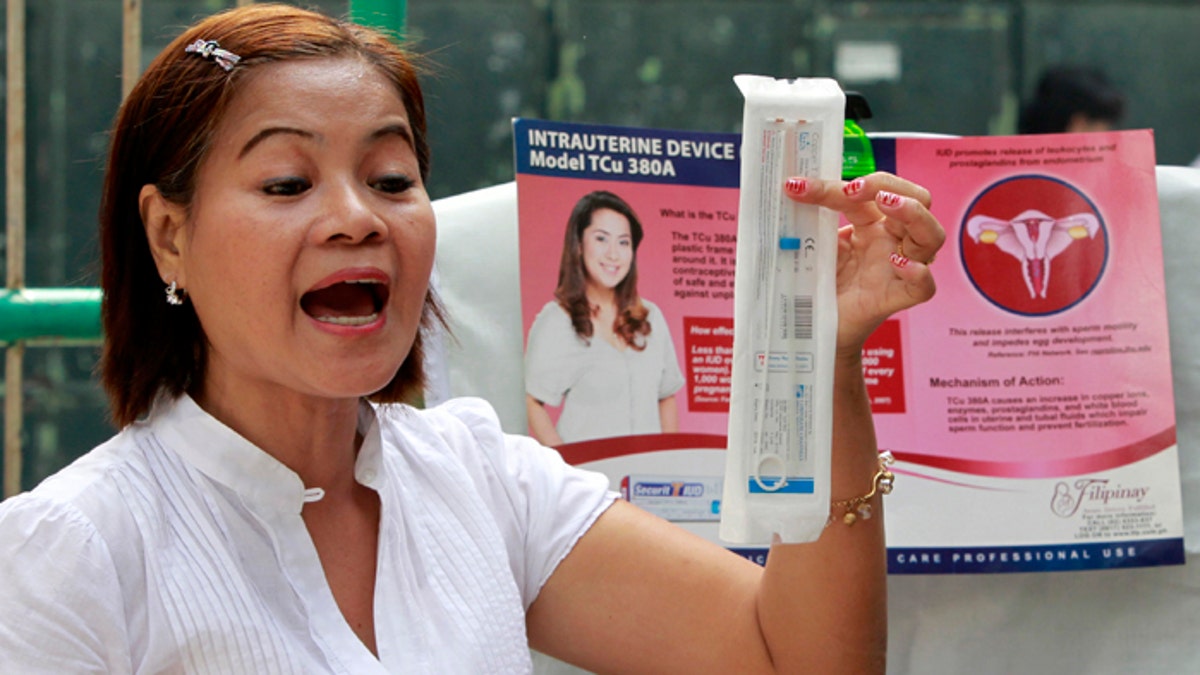
A medical worker explains a family planning method using the intrauterine device (IUD). (REUTERS/Erik de Castro)
Following a decline in popularity during the 1980s to early 2000s, use of long-acting, reversible birth control increased fivefold over the past decade, according to a report released Tuesday by the Centers for Disease Control and Prevention (CDC) National Center for Health Statistics.
These contraceptives— including intrauterine devices (IUDs) and hormonal implants— are most popular among women aged 25 to 34 who have had a child, but for the first time since the beginning of the report, in 1982, long-acting, reversible contraceptives (LARCs) are also becoming more popular among women aged 15 to 24. Despite the spike in use, overall use remains low, the report shows: About 11 percent of women aged 25 to 34 reported using LARCs from 2011 to 2013, compared to 5 percent of women aged 15 to 24 and 5.3 percent of women aged 35 to 44.
The Guttmacher Institute, an advocacy group for sexual and reproductive health and rights, estimates that about 99 percent of sexually active U.S. women have used at least one form of birth control and that 11 percent of women at risk of unintended pregnancy don’t use contraception.
Research shows that LARCs are the most effective forms of birth control besides abstaining from sexual intercourse. According to the CDC, hormonal implants, a matchstick-size rod implanted in the arm, as well as the IUD, a T-shaped device that is inserted into the uterus, both result in less than one pregnancy per 100 women annually. Implants have a .05 percent failure rate, while hormonal and copper intrauterine devices have a .2 percent or a .8 percent failure rate, respectively. The male condom has an 18 percent failure rate, while the pill has a 9 percent failure rate.
LARCs are thought to be more effective because they aren’t subject to human error and can be inserted then left alone for an extended period of time. The IUD is approved for use for anywhere from three to 10 years depending on the model, and the hormonal implant is approved for use for five years. Research published earlier this month in the journal Obstetrics & Gynecology suggests hormonal IUDs may be effective for even longer than their Food and Drug Administration (FDA)-approved use.
Some experts have speculated that IUDs in particular have been slow to catch on in the United States due to a host of health problems associated with previous models of the device in the 1970s and ’80s.
“Although better designed models were later introduced, the method has not recovered its status as a major contraceptive option for U.S. women,” Adam Sonfield, senior public policy associate at the Guttmacher Institute, wrote in a 2007 paper.
However, a small study published Monday in the journal Contraception suggests LARCs are more popular among health care providers than in the general population. Of 500 study participants, 42 percent used LARCs.
The American Academy of Pediatrics (AAP), a group of U.S. pediatricians, in September recommended the use of IUDs and hormonal implants for sexually active teenage girls.
Mary Ott, an associate pediatrics professor at Indiana University and the lead author of the AAP’s policy statement, told the Associated Press that while LARCs can cost up to hundreds of dollars without health insurance, they are actually cheaper in the long run compared to over-the-counter condoms and prescription birth control pills. The AAP recommends the use of LARCs in addition to condoms, as LARCs do not protect against sexually transmitted diseases.
The group’s advice echoed 2012 recommendations from the American College of Obstetricians and Gynecologists (ACOG), which previously attributed the high rate of unintended pregnancies in the U.S. to the low use of LARCs.
“Top-tier reversible methods share the characteristic of requiring a single act of motivation for long-term use, eliminating adherence and user-dependence from the effectiveness equation,” the ACOG wrote in a December 2009 paper. “Because of these advantages and the potential to reduce unintended pregnancy rates, LARC methods should be offered as first-line contraceptive methods and encouraged as options for most women.”
According to the CDC, in 2006 — the most recent data available— 49 percent of pregnancies in the U.S. were unintended, meaning mistimed, unplanned or unwanted at the time of conception. Among women aged 19 years and younger, more than four out of five pregnancies were unintended.
The Associated Press contributed to this report.
